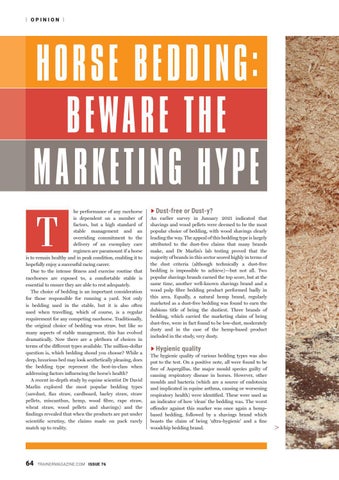| OPINION |
HORSE BEDDING BEWARE THE MARKETING HYPE T
he performance of any racehorse is dependent on a number of factors, but a high standard of stable management and an overriding commitment to the delivery of an exemplary care regimen are paramount if a horse is to remain healthy and in peak condition, enabling it to hopefully enjoy a successful racing career. Due to the intense fitness and exercise routine that racehorses are exposed to, a comfortable stable is essential to ensure they are able to rest adequately. The choice of bedding is an important consideration for those responsible for running a yard. Not only is bedding used in the stable, but it is also often used when travelling, which of course, is a regular requirement for any competing racehorse. Traditionally, the original choice of bedding was straw, but like so many aspects of stable management, this has evolved dramatically. Now there are a plethora of choices in terms of the different types available. The million-dollar question is, which bedding shoud you choose? While a deep, luxurious bed may look aesthetically pleasing, does the bedding type represent the best-in-class when addressing factors influencing the horse’s health? A recent in-depth study by equine scientist Dr David Marlin explored the most popular bedding types (sawdust, flax straw, cardboard, barley straw, straw pellets, miscanthus, hemp, wood fibre, rape straw, wheat straw, wood pellets and shavings) and the findings revealed that when the products are put under scientific scrutiny, the claims made on pack rarely match up to reality.
64
TRAINERMAGAZINE.COM ISSUE 76
• Dust-free or Dust-y?
An earlier survey in January 2021 indicated that shavings and wood pellets were deemed to be the most popular choice of bedding, with wood shavings clearly leading the way. The appeal of this bedding type is largely attributed to the dust-free claims that many brands make, and Dr Marlin’s lab testing proved that the majority of brands in this sector scored highly in terms of the dust criteria (although technically a dust-free bedding is impossible to achieve)—but not all. Two popular shavings brands earned the top score, but at the same time, another well-known shavings brand and a wood pulp fibre bedding product performed badly in this area. Equally, a natural hemp brand, regularly marketed as a dust-free bedding was found to earn the dubious title of being the dustiest. Three brands of bedding, which carried the marketing claim of being dust-free, were in fact found to be low-dust, moderately dusty and in the case of the hemp-based product included in the study, very dusty.
• Hygienic quality
The hygienic quality of various bedding types was also put to the test. On a positive note, all were found to be free of Aspergillus, the major mould species guilty of causing respiratory disease in horses. However, other moulds and bacteria (which are a source of endotoxin and implicated in equine asthma, causing or worsening respiratory health) were identified. These were used as an indicator of how ‘clean’ the bedding was. The worst offender against this marker was once again a hempbased bedding, followed by a shavings brand which boasts the claim of being ‘ultra-hygienic’ and a fine woodchip bedding brand.
